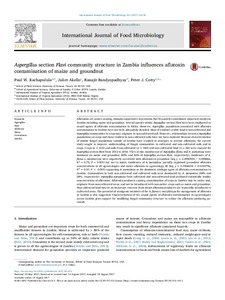| dc.contributor.author | Kachapulula, P.W. |
| dc.contributor.author | Akello, J. |
| dc.contributor.author | Bandyopadhyay, Ranajit |
| dc.contributor.author | Cotty, P.J. |
| dc.date.accessioned | 2019-12-04T11:10:16Z |
| dc.date.available | 2019-12-04T11:10:16Z |
| dc.date.issued | 2017 |
| dc.identifier.citation | Kachapulula, P.W., Akello, J., Bandyopadhyay, R. & Cotty, P.J. (2017). Aspergillus section Flavi community structure in Zambia influences aflatoxin contamination of maize and groundnut. International Journal of Food Microbiology, 261, 49-56. |
| dc.identifier.issn | 0168-1605 |
| dc.identifier.uri | https://hdl.handle.net/20.500.12478/2056 |
| dc.description | Article purchased; Published online: 19 August 2017 |
| dc.description.abstract | Aspergillus section Flavi have been implicated as causal agents of aflatoxin contamination in Africa. However, Aspergillus populations associated with aflatoxin contamination in Zambia have not been adequately detailed. Most of Zambia's arable land is non-cultivated and Aspergillus communities in crops may originate in non-cultivated soil. However, relationships between Aspergillus populations on crops and those resident in non-cultivated soils have not been explored. Because characterization of similar fungal populations outside of Zambia have resulted in strategies to prevent aflatoxins, the current study sought to improve understanding of fungal communities in cultivated and non-cultivated soils and in crops. Crops (n = 412) and soils from cultivated (n = 160) and non-cultivated land (n = 60) were assayed for Aspergillus section Flavi from 2012 to 2016. The L-strain morphotype of Aspergillus flavus and A. parasiticus were dominant on maize and groundnut (60% and 42% of Aspergillus section Flavi, respectively). Incidences of A. flavus L-morphotype were negatively correlated with aflatoxin in groundnut (log y = 2.4990935 − 0.09966x, R2 = 0.79, P = 0.001) but not in maize. Incidences of A. parasiticus partially explained groundnut aflatoxin concentrations in all agroecologies and maize aflatoxin in agroecology III (log y = 0.1956034 + 0.510379x, R2 = 0.57, P < 0.001) supporting A. parasiticus as the dominant etiologic agent of aflatoxin contamination in Zambia. Communities in both non-cultivated and cultivated soils were dominated by A. parasiticus (69% and 58%, respectively). Aspergillus parasiticus from cultivated and non-cultivated land produced statistically similar concentrations of aflatoxins. Aflatoxin-producers causing contamination of crops in Zambia may be native and, originate from non-cultivated areas, and not be introduced with non-native crops such as maize and groundnut. Non-cultivated land may be an important reservoir from which aflatoxin-producers are repeatedly introduced to cultivated areas. The potential of atoxigenic members of the A. flavus-L morphotype for management of aflatoxin in Zambia is also suggested. Characterization of the causal agents of aflatoxin contamination in agroecologies across Zambia gives support for modifying fungal community structure to reduce the aflatoxin-producing potential. |
| dc.description.sponsorship | United States Agency for International Development |
| dc.description.sponsorship | United States Department of Agriculture |
| dc.description.sponsorship | Bill & Melinda Gates Foundation |
| dc.format.extent | 49-56 |
| dc.language.iso | en |
| dc.subject | Aspergillus |
| dc.subject | Flavi |
| dc.subject | Aflatoxins |
| dc.subject | Maize |
| dc.subject | Groundnuts |
| dc.subject | Contamination |
| dc.subject | Mycotoxin |
| dc.title | Aspergillus section Flavi community structure in Zambia influences aflatoxin contamination of maize and groundnut |
| dc.type | Journal Article |
| dc.description.version | Peer Review |
| cg.contributor.crp | Agriculture for Nutrition and Health |
| cg.contributor.crp | Maize |
| cg.contributor.crp | Roots, Tubers and Bananas |
| cg.contributor.affiliation | University of Arizona |
| cg.contributor.affiliation | University of Zambia |
| cg.contributor.affiliation | International Institute of Tropical Agriculture |
| cg.coverage.region | Africa |
| cg.coverage.region | Southern Africa |
| cg.coverage.country | Zambia |
| cg.isijournal | ISI Journal |
| cg.authorship.types | CGIAR and developing country institute |
| cg.iitasubject | Maize |
| cg.journal | International Journal of Food Microbiology |
| cg.howpublished | Formally Published |
| cg.accessibilitystatus | Open Access |
| local.dspaceid | 86066 |
| cg.targetaudience | Scientists |
| cg.identifier.doi | http://dx.doi.org/10.1016/j.ijfoodmicro.2017.08.014 |

